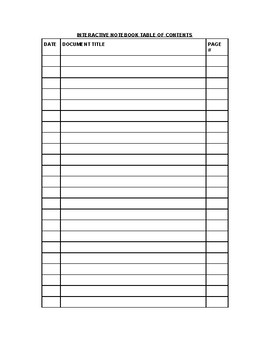Have you ever felt completely lost in a sea of scribbled notes, scientific jargon, and lab diagrams? You’re not alone! Many students struggle to keep their science notebooks organized, leading to frustration and difficulty finding vital information when it’s needed most. But what if there was a way to unlock the power of your notebook and transform it into a valuable, well-organized learning tool?

Image: www.teacherspayteachers.com
This is where the magic of a table of contents comes in. A meticulously crafted table of contents is not just a list of pages, but a roadmap to navigate your science journey with ease. It acts as a powerful tool to enhance your understanding, improve your studying, and ultimately, boost your grades. This guide will delve into the art and science of building the ultimate table of contents for your science notebook – discover how to unlock its potential and take your science learning to the next level.
Creating a Foundation: Understanding the Importance of a Table of Contents
Before we dive into specific strategies, let’s understand why a table of contents is so crucial. Imagine a library without a catalog – chaos! That’s what your notebook can be without a table of contents. It’s a simple but powerful tool that helps you:
- Save Time: Finding the specific information you need becomes a breeze. You don’t have to flip through pages aimlessly.
- Improve Your Study Habits: A clear table of contents makes your notes more accessible, enhancing your review sessions and boosting your retention.
- Enhance Your Organization: Keep your science notebook structured and easy to navigate. It’s like having a digital mind map for your scientific explorations.
- Make Note-Taking More Effective: Knowing you have a reliable organizational system encourages you to take precise and detailed notes.
Building a Strong Spine: The Essential Elements of Your Table of Contents
Now, let’s break down the key components of a winning table of contents that will elevate your science notebook:
1. The Core: Subject and Unit Organization
Think of your table of contents as a hierarchical structure. Start by dividing your notebook into subjects (like Biology, Chemistry, Physics). Within each subject, you’ll create separate sections for each unit you cover. This initial categorization helps you quickly locate a specific concept.
Example:
- Biology
- Unit 1: Cell Biology
- Unit 2: Genetics
- Unit 3: Ecology
- Chemistry
- Unit 1: Atomic Structure
- Unit 2: Chemical Reactions
- Unit 3: Organic Chemistry

Image: www.teacherspayteachers.com
2. The Detail: Specific Topic and Page Numbers
For each unit, list the subtopics within that unit, including the corresponding page numbers. This is where the real power of your table of contents comes in! You can quickly find specific experiments, definitions, formulas, or important theories.
Example:
- Chemistry
- Unit 1: Atomic Structure
- Atomic Models (Page 15)
- Electron Configuration (Page 21)
- Isotopes and Radioactive Decay (Page 28)
- Unit 2: Chemical Reactions
- Balancing Equations (Page 45)
- Types of Reactions (Page 52)
- Stoichiometry (Page 60)
- Unit 1: Atomic Structure
3. The Key: Adding Visual Aids and Color Coding
Make your table of contents stand out by incorporating visual elements and using strategically placed color coding. Highlight key topics using different colors to easily distinguish important concepts. You can also add symbols or icons to represent different types of notes.
Example:
- Use a green highlighter to denote experimental notes.
- A blue pen to underline definitions.
- A star beside complicated formulas.
4. The Advantage: Index for Glossary and Lab Reports
Don’t forget to include an index for your glossary (if you have one) and your lab reports. These sections are essential for quick reference and organization.
Example:
- Glossary (Page 75)
- Lab Reports (Page 81)
5. The Flexibility: Adapting to Your Science Needs
Remember, your table of contents is not set in stone! As you progress through the semester or year, add new sections, rearrange existing ones, or refine the details as needed. The key is to create a system that works best for your unique learning style.
Boosting Your Success: Expert Tips and Actionable Strategies
Now that you understand the building blocks of a stellar table of contents, let’s discuss how to make it truly work for you. Here are some expert-driven tips to implement:
Tip 1: Embrace Clarity and Simplicity: Avoid overly complex or wordy descriptions. Keep your table of contents concise and to the point.
Tip 2: Don’t Forget the Dates: Include the date next to each entry. This will help you track your progress and remind you of the context of your notes.
Tip 3: Leave Room for Growth: Use a spiral notebook or binder to allow for easily adding pages or rearranging your notes.
Tip 4: Don’t Be Afraid to Experiment: Try different table of contents formats and colors to see what works best for your personal preferences.
Tip 5: Create a “To-Do” List: Turn your table of contents into a dynamic learning tool by adding a “To-Do” list at the end. Include topics that need further review, experiments to complete, or areas to revisit.
Table Of Contents For Science Notebook
A Powerful Tool for Your Scientific Journey
Your science notebook is more than just a collection of papers. It’s a repository of your scientific journey. A carefully crafted table of contents transforms your notebook from a chaotic mess into a powerful resource that helps you excel in your studies.
Embrace the science of organization, personalize your approach, and unleash the power of a well-structured table of contents. It’s your key to unlocking better understanding, improving your study habits, and conquering your science goals!






